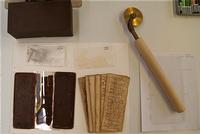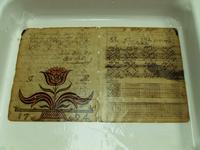If I were an 18th century manuscript, and had a broken spine, and detached boards, not to mention all kinds of other injuries to my pages, I think I would contact the Conservation Center for Art & Historic Artifacts (CCAHA) for a restoration appointment because I know that a lot of careful and expert work is needed to restore a manuscript.
Take for instance Borneman Manuscript 1, “The Hymnal of the Pietists of the Wissahickon,” part of the Borneman Pennsylvania German Manuscript Collection at the Free Library of Philadelphia, and presently at CCAHA for conservation. It has many of the problems common to 18th century manuscripts. CCAHA technicians have focused on the leather cover which is very worn and has dried out over time. This has caused leather loss and deterioration to the boards and spine, leaving the boards detached.
The Borneman Manuscript 1 dates from ca. 1709. Over time and with use, the pages have become discolored and soiled, and small edge tears and losses are present. The unknown scrivener of this document used gall ink, the standard writing and drawing ink from about the 12th century well into the 20th century. This type of ink contains iron salts and tannic acids, which eventually will eat into the paper, causing paper loss. Where heavily applied, the iron gall ink has begun to sink through the paper of our manuscript.
As a first step towards conservation, CCAHA technicians have carefully disbound the boards and spine, leaving the leaves in sections, called gatherings. Initially, the text leaves will be surface cleaned, and where necessary receive an aqueous treatment to arrest the corrosive properties of the iron gall ink, ensuring against any further paper loss. This is extremely important because iron gall ink can destroy whole sections of valuable text, and/or drawings, leaving major irreplaceable gaps in a work. After treatment, the paper leaves will be resized, and major tears mended. Following this, the technicians will bridge losses, and guard spine folds of text leaves with appropriate materials. They will then re-sew the volume, approximating its original sewing configuration as nearly as possible. The leather will be repaired; the book re-backed with sympathetic materials, including as much of the original spine piece as possible; and the board edges and corners mended. The conservation of this valuable link to America’s past will guarantee that the original will be preserved for future generations.
While at CCAHA, “The Hymnal of the Pietists of the Wissahickon,” will be fully digitized, enabling the Free Library of Philadelphia to offer it online as part its Borneman Pennsylvania German Manuscript Digital Collection. A global audience will soon have unlimited instantaneous access to fascinating and valuable historic insights of common and not so common men from a very important time and place in American history.
Visit our Facebook gallery for examples of other manuscripts undergoing similar treatment, and demonstrating some of the processes described above, but not yet undertaken on Borneman Manuscript 1.
Preservation of the Free Library of Philadelphia's Pennsylvania German manuscript collection has been made possible in part by a major grant from the National Endowment for the Humanities: Because democracy demands wisdom. Any views, findings, conclusions, or recommendations expressed in this post do not necessarily represent those of the National Endowment for the Humanities.
Have a question for Free Library staff? Please submit it to our Ask a Librarian page and receive a response within two business days.



